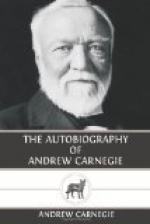animal pets, 23;
early evidence of organizing power, 24, 43;
leaves Dunfermline, 25;
sails for America, 28;
on the Erie Canal, 29, 30;
in Allegheny City, 30;
becomes a bobbin boy, 34;
works in a bobbin factory, 35, 36;
telegraph messenger, 37-44;
first real start in life, 38, 39;
first communication to the press, 45;
cultivates taste for literature, 46, 47;
love for Shakespeare stimulated, 48, 49;
Swedenborgian influence, 50;
taste for music aroused, 51;
first wage raise, 55;
learns to telegraph, 57, 58, 61;
becomes a telegraph operator, 59.
Railroad experience:
Clerk and operator for Thomas A. Scott,
division superintendent of
Pennsylvania Railroad, 63;
loses pay-rolls, 67;
an anti-slavery partisan, 68, 96;
employs women as telegraph operators,
69;
takes unauthorized responsibility, 71,
72;
in temporary charge of division, 73;
theological discussions, 74-76;
first investment, 79;
transferred to Altoona, 84;
invests in building of sleeping-cars,
87;
made division superintendent on the Pennsylvania
Railroad, 91;
returns to Pittsburgh, 92;
gets a house at Homewood, 94;
Civil War service, 99-109;
gift to Kenyon College, 106;
first serious illness, 109;
first return to Scotland, 110-13;
organizes rail-making and locomotive works,
115;
also a company to build iron bridges,
116-18;
bridge-building, 119-29;
begins making iron, 130-34;
introduces cost accounting system, 135,
136, 204;
becomes interested in oil wells, 136-39;
mistaken for a noted exhorter, 140;
leaves the railroad company, 140, 141.
Period of acquisition: Travels extensively in Europe, 142, 143; deepening appreciation of art and music, 143; builds coke works, 144, 145; attitude toward protective tariff, 146-48; opens an office in New York, 149; joins the Nineteenth Century Club, 150; opposed to speculation, 151-54; builds bridge at Keokuk, 154; and another at St. Louis, 155-57; dealings with the Morgans, 155-57, 169-73; gives public baths to Dunfermline, 157; his ambitions at thirty-three, 157, 158; rivalry with Pullman, 159; proposes forming Pullman Palace Car Company, 160; helps the Union Pacific Railway through a crisis, 162, 163; becomes a director of that company, 164; but is forced out, 165; friction with Mr. Scott, 165, 174; floats bonds of the Allegheny Valley Railway, 167-71; negotiations with Baring Brothers, 168, 169; some business rules, 172-75, 194, 224, 231; concentrates on manufacturing, 176, 177; president of the British Iron and Steel Institute, 178; begins making pig iron, 178, 179; proves the value of chemistry at a blast furnace, 181-83; making steel rails, 184-89; in the panic of 1873, 189-93; parts with Mr. Kloman, 194-97; some of his partners, 198-203; goes around the world, 204-09;




